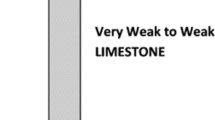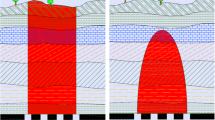Abstract
A 1/20 scale experimental dozer push test rig was designed and constructed to quantify the expected production rates (loose cubic metres per hour) for dozers operating in hard rock bulk push applications. The particle size distribution of the material employed in the test rig was modelled on a fragmented muckpile representative of that for a typical surface copper/gold mine overburden. A commercially available road base material was found to be highly representative of site conditions. Buckingham Pi theory was applied to mathematically develop factors for scaling up dozer productivity parameters, including blade loads and push times. Dozer production rates were investigated for various dozing distances and slope angles. A series of instantaneous productivity curves were produced which are applicable for use in hard rock dozer push operations. Currently, it is difficult to estimate dozer push productivity in hard rock environments due to dozer productivity correction factors that are empirical in nature and provide only discrete, end-point values for a range of operating conditions. The productivity curves produced demonstrate that dozer productivity declines rapidly over the range of 10 m to 40 m. As such, it is recommended that efficient bulk dozing operations in hard rock mining blocks should not exceed 40 m dozing distance. Further testing of muckpile conditions with increased clay and moisture content would be beneficial in order to better understand and quantify the effects of cohesion on hard rock dozer push productivity.











Similar content being viewed by others
Data Availability
The experimental data is not available to the general public.
Code Availability
Not applicable.
Abbreviations
- BCM:
-
Bank Cubic Metres
- DC:
-
Direct Current
- DEM:
-
Discrete Element Method
- DoE:
-
Design of Experiments
- IPCC:
-
In-Pit Crushing and Conveying
- FMIPCC:
-
Fully-Mobile In-Pit Crushing and Conveying
- LCM:
-
Loose Cubic Metres
- PFC:
-
Particle Flow Code
- PSD:
-
Particle Size Distribution
- SATS:
-
Semi-Autonomous Tractor System
- SMIPCC:
-
Semi-Mobile In-Pit Crushing and Conveying
References
Hays RM (1990) Dozers. In: Kennedy BA (ed) Surface Mining, 2nd edn. Society for Mining, Metallurgy and Exploration, Littleton, Colorado, pp 716–723
Medland D, Mether R (2006) Radical Mining Process Change Is Possible. 2006 Australian Mining Technology Conference 'Value through Cost Control'. Hunter Valley, NSW: The Australasian Institute of Mining and Metallurgy. (AUSIMM), pp 397–410
Aspinall TO, Davidson AL, Hagan TN, Isles PT, McManus DA, Smith GH (1993) Strip Mining Australia Cola Mining Monograph 12, Martin CH, Hargraves AJ (eds) Australasian Institute of Mining and Metallurgy, Melbourne, pp 203–223
Doktan M, Scott A, Cocker A (1998) Optimisation of Dozer Operations in Open Cut Mines, pp 89–105 (Australian Coal Association Research Program: Brisbane), Julius Kruttschnitt Mineral Research Centre, (JKMRC)/ACARP Project C5008
MEC Mining, (2017) Dozer Bulk Push Training Program Presentation by T Boulton. mecmining.com.au/how-to-plan-dozer-push. Accessed 20 Jul 2020
Isles JJ (2003) Implementing production dozing at Tarong coal mine, Honours thesis (unpublished), University of Queensland, Brisbane
Cunningham J (2013) Economic optimisation of dozer push operations for typical open cut coal mines, Honours thesis (unpublished), University of Queensland, Brisbane
N Sinclair, M Nehring (2019) Dozer ‘side-cutting’ versus excavator side-casting on the highwall in dozer bulk push operations” Journal of SAIMM 119:71–80
Uren Z, Nehring M (2015) Development of dozer push optimisation software for Commodore coal mine. Min Technol 124(4):231–238. https://doi.org/10.1179/1743286315Y.000000001
Osanloo M, Paricheh M (2020) In-pit crushing and conveying technology in open-pit mining operations: a literature review and research agenda. Int J Min Reclam Environ 34(6):430–457
Knights P (2017) “Dozers the answer to IPCC woes”. http://www.miningmagazine.com/top-articles/dozers-the-answer-to-ipcc-woes/. Accessed 15 Aug 2017
Atchinson T, Morrison D (2011) In-Pit Crushing and Conveying Bench Operations, Proc. AusIMM Iron Ore Conference, Perth, WA, 11–13 July 2011
Beilby P (2009) Iluka Resources Ltd presentation at AJM Mineral Sand Conference, Mildura, Dec 2009, available at www.iluka.com/docs/company-presentations/ajm-mineral-sands-conference---mildura-presentation-by-peter-beilby-gm-murray-basin-december-2009. Accessed 8 Aug 2017
Medland D (2020) The Art and Science of Dozer Mining: A Personal Review and Commentary, 3rd Ed., Medland Mining Services Pty Ltd, available from dozerdave@medlandmining.com.
Klanfar M, Kujundžić T, Vrlian D (2014) Calculation analysis of Bulldozers's Productivity in Gravitational transport on Open Pits. Tehnicki vjesnik/Technical Gazette 21(3)
Caterpillar (2017). Caterpillar performance handbook 47, pp19–1–19–57 (Caterpillar: Peoria)
Wismer RD (1982) Soil dynamics: a review of theory and practice. SAE Transactions, Vol 91, Section 2: 82024–820688, 2266–2278
Reece A (1984) A rational approach to the design of earth-moving machines. J Terramech 21(1):69–79
Ur Rehman A, Awuah-Offei K (2020) Understanding how speed, tractive effort, digging height and rake angle affect bucket penetration and resistive forces for rubber tyred loaders. Mining, Metallurgy and Exploration 37:1423–1435
Ghorbani S, (2019) Simulation of Soil-to-Tool Interaction Using Discrete Element Method (DEM) and Multibody Dynamics (MBD) Coupling
Nezami EG, Hashash YMA, Zhao D, Ghaboussi J (2007) Simulation of front end loader bucket-soil interaction using discrete element method. Int J Numer Anal Methods Geomech 31(9):1147–1162
Garrity RJ, Kolthoff CP, Reaves CA, Schafer RL (1968) A test comparison of model and full-sized bulldozer blades, SAE Paper 680612
Sullivan RJ (1964) Earthmoving in miniature. SAE paper 897B. J Terramech 1(4):85–106
Leonard S, Lever P, Shekar R (2009) “Development of a semi-autonomous scale dragline excavation research tool”, 2009 Australian Mining Technology Conference, Brisbane, Queensland, 27–28:45–54
Castro R, López S, Gómez R, Ortiz S, Carreño N (2021) Experimental study of the influence of drawbell geometry on hang-ups in cave mine applications. Rock Mech Rock Eng 54:1–10. https://doi.org/10.1007/s00603-020-02247-4
Onederra I, Mardones F, Scherpenisse C (2010) Application of stochastic approach to blast fragmentation modelling. Min Technol 119(4):221–232
Buckingham E (1915) Model experiments and the forms of empirical equations. Trans Am Soc Mech Eng 37:263–296
Moinfar AM, Shahgholi G (2018) Dimensional analysis of the tractor tractive efficiency parameters. Acta Technologica Agriculturae 3:94–99. https://doi.org/10.2478/ata-2018-0017
Ur Rehman A, Awuah-Offei K, Sherizadeh T (2020) Discrete Element Modelling of Scaled Bucket Excavation. 54th U.S. Rock Mechanics/Geomechanics Symposium, 28 June - 1 July, American Rock Mechanics Association
Hanche-Olsen H (2004). "Buckingham's pi-theorem" NTNU. Available at https://folk.ntnu.no/hanche/notes/buckingham/buckingham-a4.pdf. Accessed 7 June 2020
Acknowledgements
The authors would also like to express their gratitude to Mr Allan Atkinson and Mr Eric Muhling, recently retired from his role as Underground Mine Manager for the UQ Experimental Mine, who greatly assisted with the design and fabrication of the experimental dozer push rig.
Funding
The research leading to these results was funded by Newcrest Mining Limited under a University of Queensland/Newcrest Mining Limited PhD scholarship agreement.
Author information
Authors and Affiliations
Corresponding author
Ethics declarations
Ethics Approval and Consent to Participate
Not applicable.
Consent for Publication
The authors and Newcrest Mining Limited consent to the publication of this manuscript.
Conflict of Interest
The authors declare that they have no financial interests associated with this publication.
Additional information
Publisher’s Note
Springer Nature remains neutral with regard to jurisdictional claims in published maps and institutional affiliations.
Rights and permissions
About this article
Cite this article
Rea, R., Knights, P. & Kizil, M. A Scale Model Experimental Study for Estimating the Productivity of Bulk Push Dozer Operations in Hard Rock Mining. Mining, Metallurgy & Exploration 39, 63–75 (2022). https://doi.org/10.1007/s42461-021-00505-9
Received:
Accepted:
Published:
Issue Date:
DOI: https://doi.org/10.1007/s42461-021-00505-9




